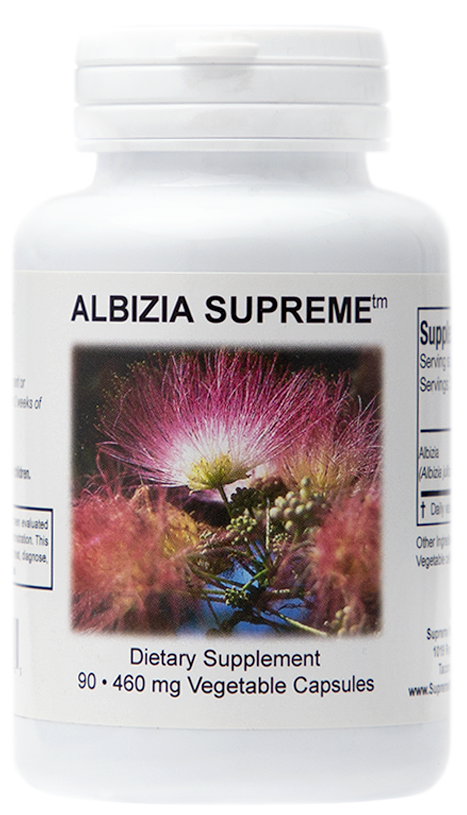 Habitat and intro:
Habitat and intro:
Albizia (Albizia julibrissin) is a beautiful tree native to China, Korea, and Japan whose flowers and bark have long been valued as an exceptional medicine that was reputed to bring joy to the heart. In Chinese Medicine the energy of Albizia was considered to enter the heart and liver meridians and functions to release suppressed emotion and calm the heart and mind[1].
Chemical Constituents:
Albizia bark contains albitocin, b-sitosterol, amyrin, 3,4,7-trihydroxyflavone, spinasterylglucoside, machaerinic acid, lactone, methyl ester, acaci acid, hehuanoside A, and lactones[2][3]. Albizia also contains three novel saponins: julibrosides I-III[4].
Historical Use:
Some of its Chinese names translate to ‘happiness herb’ or ‘happiness bark’[5]. Albizia has been used to help relieve stress, anxiety, support mood. It is considered to be a calming spirit herb and has even been used to treat difficult mental emotional conditions like depression and grief. Albizia has also been historically used to treat insomnia, poor memory, irritability, and anger from suppressed emotions. The bark has also been highly valued to help healing of external wounds and bone fractures. Ancient Chinese texts refer to its ability to help grow flesh and muscle, and reconnect sinew and bone. Albizia was reputed to nourish the five yin organs of the body: heart, liver, spleen, lungs, kidney, and pericardium. According to the Divine Husbandman’s Classic of the Materia Medica, Albizia bark “quiets the five yin organs, focuses the mind, and makes people happy without care. Long-term consumption will lighten the body, brighten the eyes and allow people to achieve their desires.” Albizia has also been used historically to treat abscesses and boils. [6]
Modern science:
Several of the flavonol glycosides from Albizia including quercetrin and isoquercetrin have shown to have sedative activity[7].
A significant anti-depressant effect of Albizia extract has been demonstrated, likely via the serotonin 5-HT1A receptor system[8] and GABA receptor system[9].
Albizia stem extracts have been shown to have potent antioxidant scavenging ability, up to 6 times stronger than vitamin C[10]. It has potent neuroprotective effects and has been shown to enhance mitochondrial function[11].
Some authors consider Albizia bark could be an anti-anxiety drug candidate[12].
Albizia bark has been shown to suppress tumor growth and angiogenesis[13][14][15].
Saponin fractions of Albizia have been shown to stimulate immune function[16].
Extracts of Albizia have been shown to be strongly anti-inflammatory via TNF-α-and NF-κB inhibition[17].
Clinical use:
I find this herb to be deeply nourishing for the nervous system and can help stabilize and uplift mood. Many patients suffering from depression, anxiety, insomnia, excess anger or grief may find incredible relief with taking Albizia. It tends to be calming more than sedating and helps to ease a busy mind. It is a very uplifting herb compared to other herbs of its class like Ashwaganda and tends to significantly improve mood. Whereas Ashwaganda is calming but helps restore energy at the same time, Albizia tends to have a stronger relaxing, uplifting effect on the mood. Albizia can be a very useful herb in those suffering from insomnia secondary to grief or short temper.
Suggested dose:
Albizia bark is very safe and has been dosed up to 15g daily[18]. For many people 2-3 caps daily is adequate to achieve a positive effect.
Contraindications:
Avoid in pregnancy as this herb has been shown to stimulate contractions of the uterus.
[1] Chen and Chen, Chinese Medical Herbology, Art of Medicine Press, 2001, pg 768-769
[2] J Asian Nat Prod Res. 2008 Jul-Aug;10(7-8):781-5. doi: 10.1080/10286020802031056
[3] Xian Dai Zhong Yao Yao Li Xue (Contemporary Pharmacology of Chinese Herbs), 1997: 1097
[4] J. Nat. Prod., 1997, 60 (2), pp 102–107 DOI: 10.1021/np960556t
[5] Chen and Chen, Chinese Medical Herbology, Art of Medicine Press, 2001, pg 768-769
[6] Chinese Herbal Medicine Materia Medica (revised edition), Bensky, Gamble, & Kaptchuk
[7] J Ethnopharmacol. 2000 Jul;71(1-2):321-3.
[8] Pharmacol Biochem Behav. 2007 May;87(1):41-7. Epub 2007 Apr 6.
[9] Prog Neuropsychopharmacol Biol Psychiatry. 2013 Jul 1;44:184-92. doi: 10.1016/j.pnpbp.2013.02.012.
[10] Arch Pharm Res. 2003 Jun;26(6):458-62.
[11] Drug Chem Toxicol. 2017 Dec 18:1-8. doi: 10.1080/01480545.2017.1413106.
[12] Molecules. 2017 Aug 11;22(8). pii: E1331. doi: 10.3390/molecules22081331.
[13] Mol Med Rep. 2015 May;11(5):3405-13. doi: 10.3892/mmr.2015.3228.
[14] Phytomedicine. 2009 Aug;16(8):703-11. doi: 10.1016/j.phymed.2009.01.002.
[15] Chem Pharm Bull (Tokyo). 2006 Aug;54(8):1211-2.
[16] Int Immunopharmacol. 2014 Oct;22(2):346-55. doi: 10.1016/j.intimp.2014.07.021.
[17] Evid Based Complement Alternat Med. 2012;2012:983023. doi: 10.1155/2012/983023.
[18] Chinese Herbal Medicine Materia Medica (revised edition), Bensky, Gamble, & Kaptchuk
